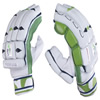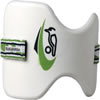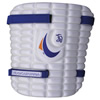Batting Equipment
For a batsman, it is indispensable to wear
protective gear, as a hard ball of around 160
grams can do serious damage, especially when
propelled towards him at more than 140 kmph.
Despite the use of following equipment, bruises
or bumps are regular for a batsman; however
their use increases the safety level to a
considerable proportion.
Helmet:

In
earlier days, a helmet used to come without a
faceguard. However, nowadays, it has become
mandatory to use one with a faceguard, with an
optimum space between the peak of the helmet and
the grill, such that the ball can't pass through
it. Usually, players use helmets only while
batting against a pace bowler. However, it's
recommended that it be kept on even while facing
slower bowlers as a precaution against a
full-toss, or a top-edged sweep or pull shot.
Gloves:

What's
the most common injury that a batsman can face?
It has to be broken fingers, considering that
the hands are the closest part to the ball at
the time of the impact with the bat, and just a
little misjudgment on the batsman's part, or an
unexpected bounce, could cause the injury.
Modern gloves are designed in such a way that
they provide the most protection, in the form of
padded areas on each finger, while being
lightweight to not cause any discomfort in
holding the bat. A pair of gloves also has
unique thumb padding on the bottom hand piece,
which is the right hand for a right-handed
batter and left hand for a left-hander, as it is
usually the bottom hand that is most susceptible
to injury because of awkward bounces off the
pitch. Some gloves also have a similar
protection, to that of the thumb, on the first
two fingers of the bottom hand piece, for extra
protection.
Elbow Guard:
The uneven bounce mentioned above can also cause
serious damage to the elbow, which is why elbow
guard has been added to the list of modern
equipments. It is worn on the bottom hand,
because of the same logic mentioned above, and
is made of a harder material than the padding
for the gloves. Not all batsmen have to wear it;
it's entirely down to personal preference. For
some, the elbow guard might cause discomfort in
playing a shot.
Chest Guard:

Similar
to the elbow guard in its material, a chest
guard is worn on the right side by a
right-hander and the left by a left-hander, to
keep in with the same logic of which side of a
batsman's body is more exposed towards the
incoming ball. It too isn't used by all batsmen,
because of the discomfort that the padding
around the waist might cause. Still, just like
the elbow guard, its use has become almost
mandatory on bouncy tracks.

Box:
If fingers are the most susceptible part of the
body to injury while batting, what we'll refer
to as the "privates" are the most painful part
for a ball to be hit, with impact, particularly
for men. Which is why the box is one of the most
important piece of equipment that a batsman
should use; it is available in various shapes
and sizes, and is ergonomically designed. These
days it even comes with suitable ventilation!

Thigh Pad:
Thigh guard is a lightweight piece of equipment
worn on the outside of the thing on the side
exposed to the bowler, for protection against
balls keeping low and potentially causing injury
or bruises, especially when coming at a quick
pace. Two straps, one around the waist, and one
around the inner thigh, hold the guard in place.
It, too, isn't used as much by batsmen, because
of the prospects of nagging caused by it.

Pads:
Next to the "privates", the shins is the most
sensitive body part where a ball striking with
force can cause unbearable pain, which is why,
like gloves, pads are an integral part of a
batsman's gear. Traditionally, pads are known to
cause trouble while running between the wickets,
especially when not fixed properly, however the
modern lightweight pads make sure that it isn't
much of a discomfort running while having them
on, without compromising on the safety factor.
The pads are made up of similar materials as the
gloves, with a horizontal panel just around the
knee height for extra protection. Most pads come
with three straps, which make it easier to
adjust the grip or position.

Shoes:
A batsman can choose their shoes' type depending
on the wicket they'd be playing and running on.
It is known that spike shoes are good for
playing on soft grounds, while rubber soles for
hard surfaces. Batsmen use a combination of
both, with spikes at the front, which provides
proper gripping while running between the
wickets, and rubber heels for the harder surface
of the pitch compared to the field.
Bat:
 You
wouldn't be a batsman without the most important
equipment of all, with which you'd hit the ball
- a bat. Bats come in different sizes and
shapes; however it's not a fixed range that is
suitable for a particular type or age of a
batsman. Instead, bats should be selected purely
on personal preference; it's necessary that you
use a bat which you feel most comfortable with.
Usually though, a bat size can be said perfect
for you, if its handle reaches the top of your
thigh, while standing upright. Bats are also
available with variable weights, which too comes
down to personal preference for choosing. A bat
of a particular weight, with which you can play
the shots requiring more top hand effort,
without much trouble or pain, should be the
best. As per the rules set by MCC, a bat
shouldn't be more than 38 inches or 96.5 cm in
length, with the blade not exceeding 4 1/4 in or
10.8 cm at the widest part. The material used
for protection of the blade should not exceed
1/16 in or 1.56 mm in thickness, and should not
be likely to cause unacceptable damage to the
ball.
You
wouldn't be a batsman without the most important
equipment of all, with which you'd hit the ball
- a bat. Bats come in different sizes and
shapes; however it's not a fixed range that is
suitable for a particular type or age of a
batsman. Instead, bats should be selected purely
on personal preference; it's necessary that you
use a bat which you feel most comfortable with.
Usually though, a bat size can be said perfect
for you, if its handle reaches the top of your
thigh, while standing upright. Bats are also
available with variable weights, which too comes
down to personal preference for choosing. A bat
of a particular weight, with which you can play
the shots requiring more top hand effort,
without much trouble or pain, should be the
best. As per the rules set by MCC, a bat
shouldn't be more than 38 inches or 96.5 cm in
length, with the blade not exceeding 4 1/4 in or
10.8 cm at the widest part. The material used
for protection of the blade should not exceed
1/16 in or 1.56 mm in thickness, and should not
be likely to cause unacceptable damage to the
ball.